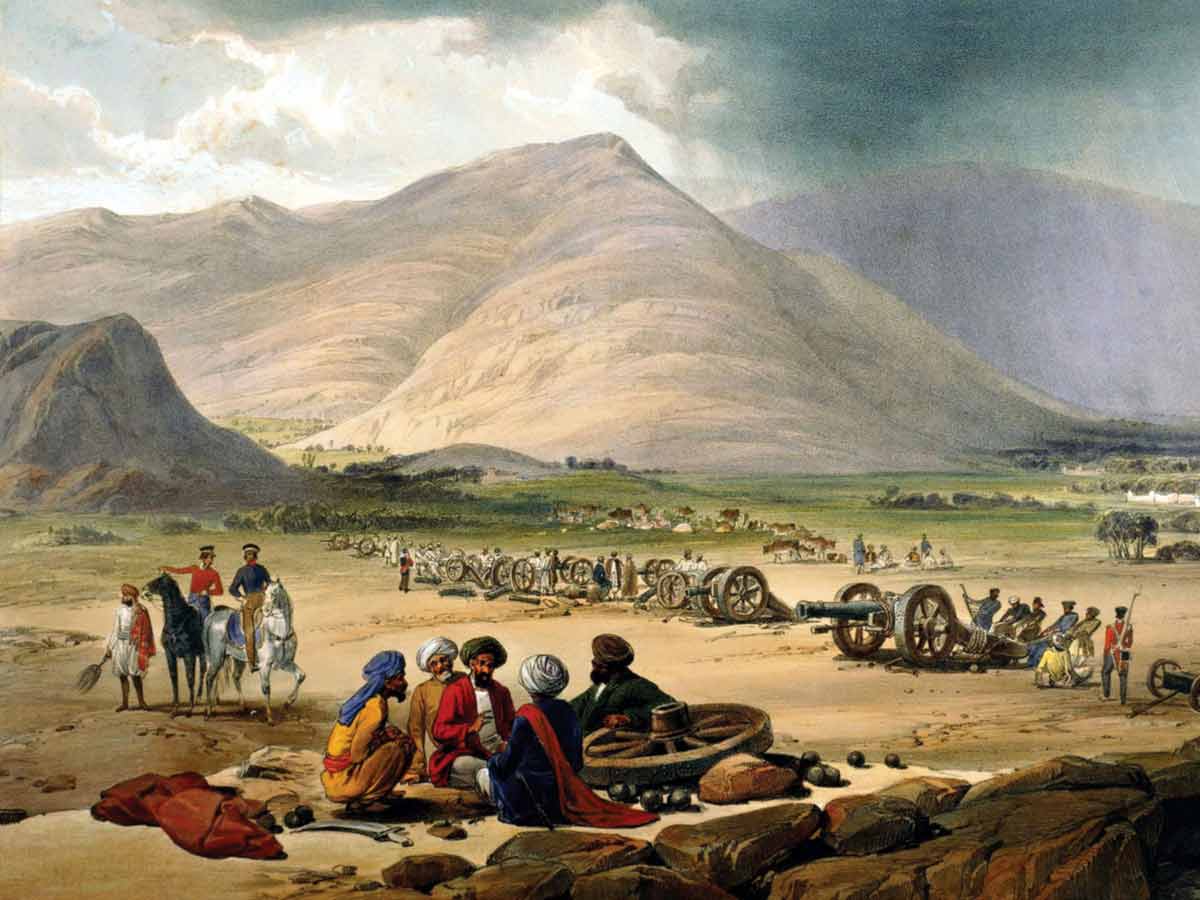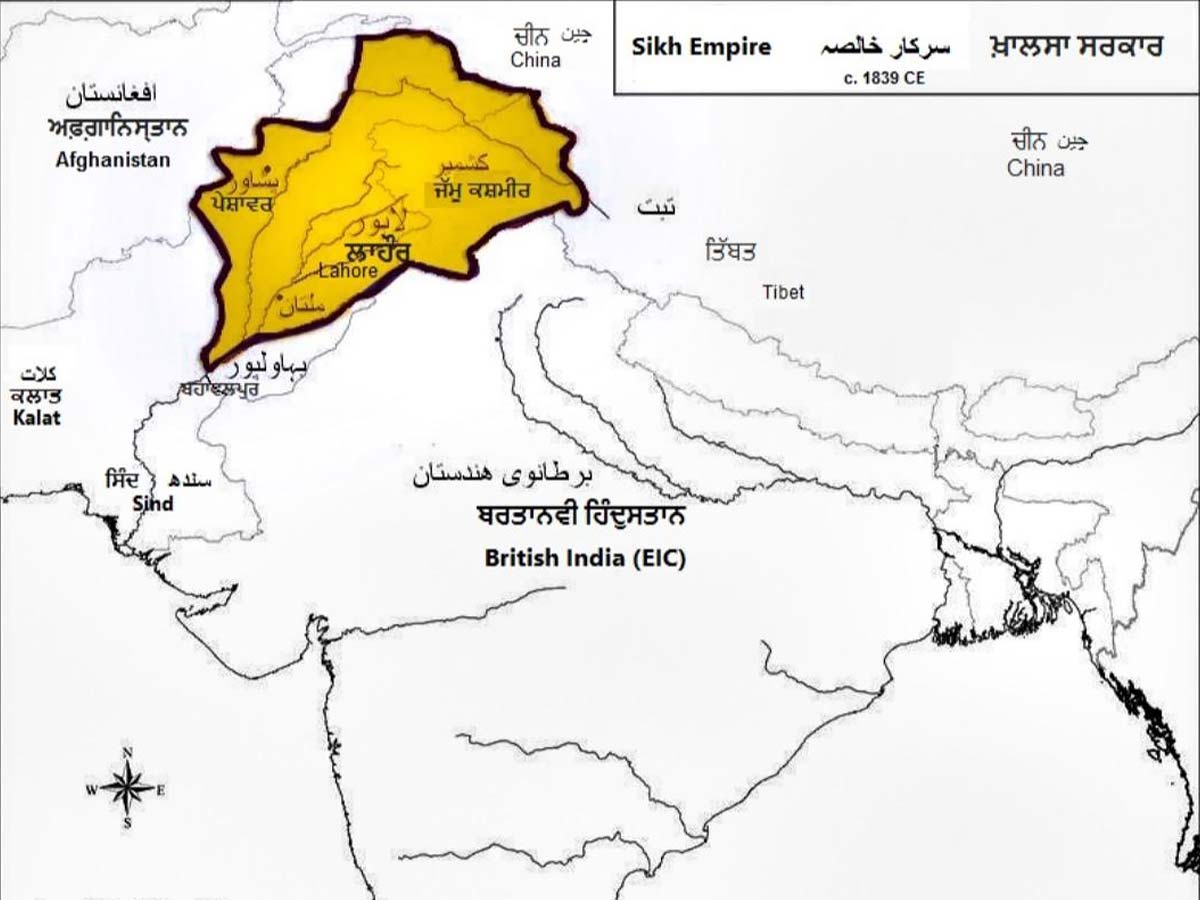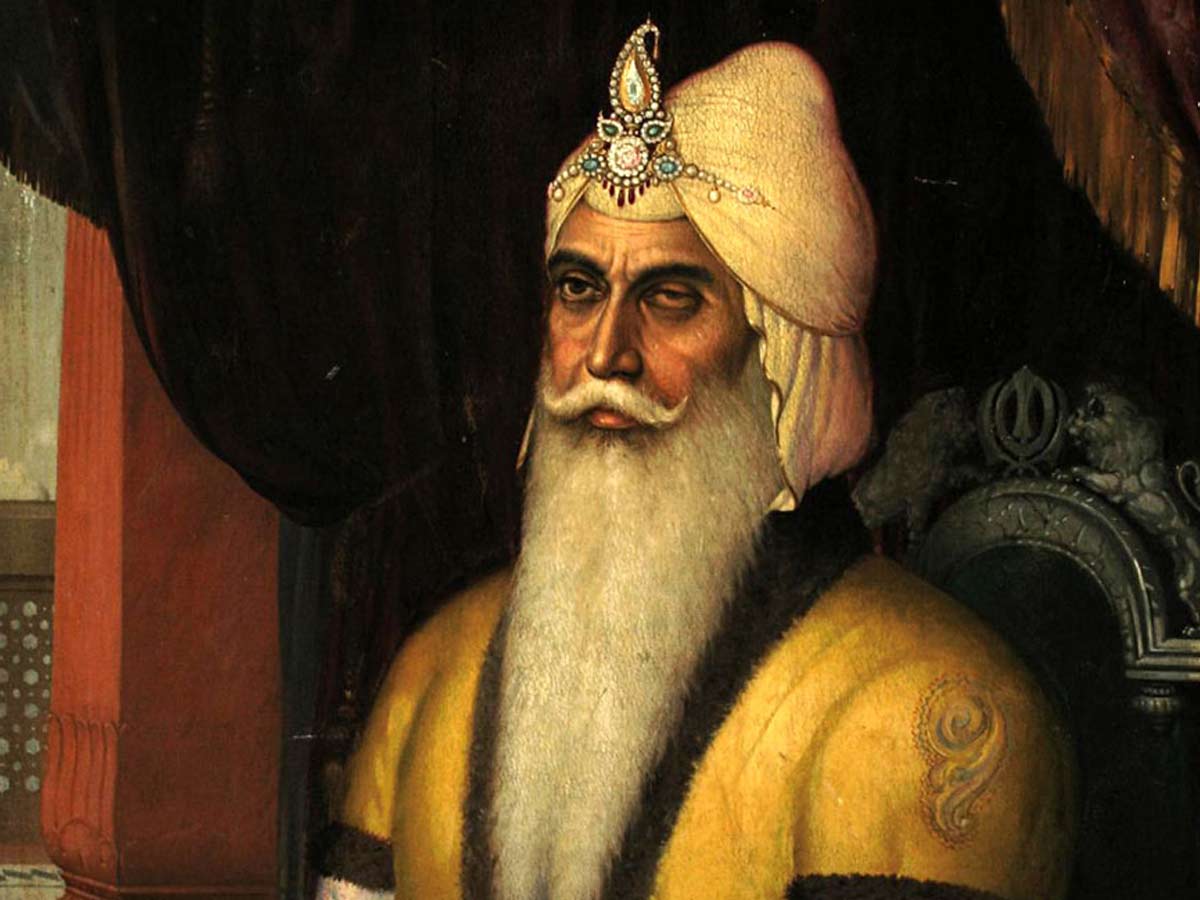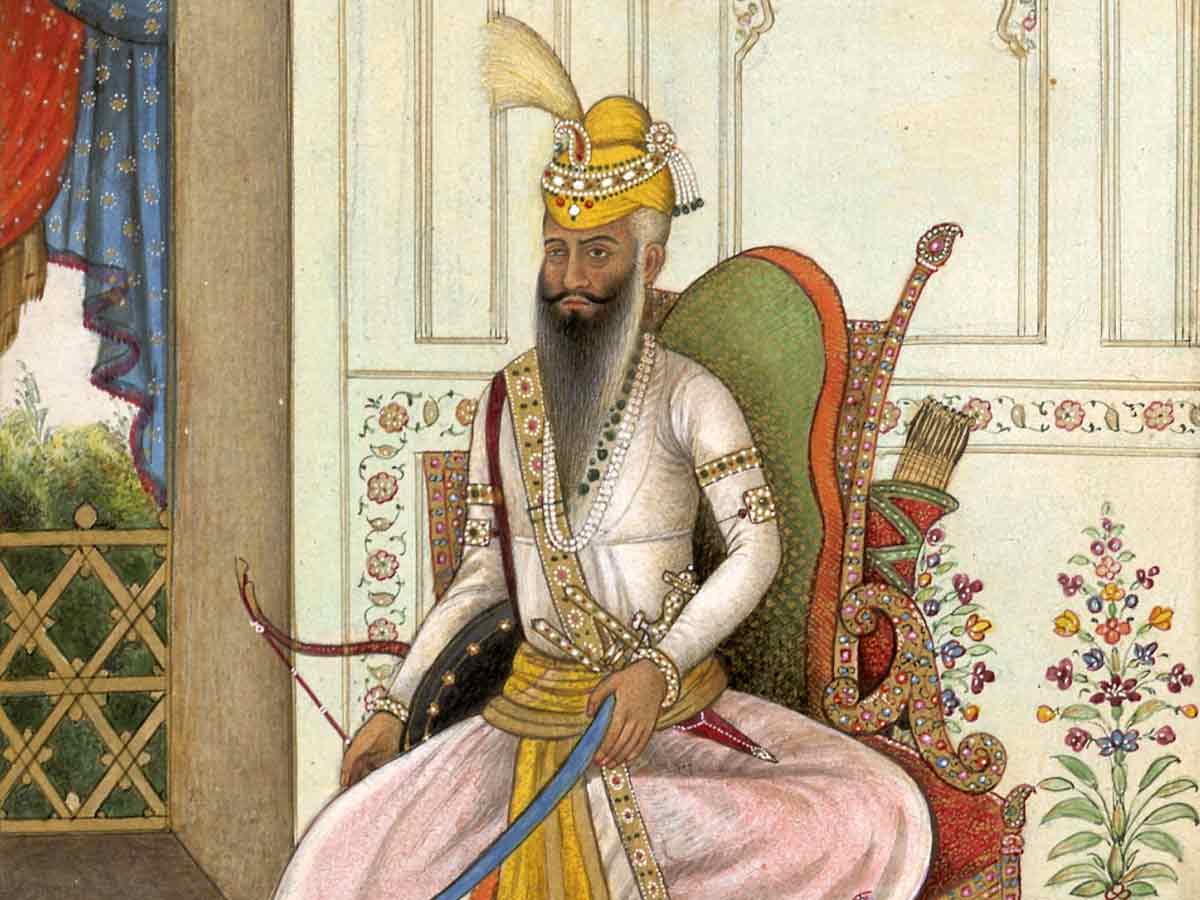Maharaja Ranjit Singh, also known as the Lion of Punjab, was the founder and Maharaja of the Sikh kingdom of Punjab from 1801 to 1939.
Ranjit Singh was the very first Indian in millennia to turn the tide of conquest back into the homelands of India’s conventional conquerors, the Pashtuns (Afghans), earning him the moniker “Lion of Punjab.” His domains stretched from the Khyber Pass in the northwest to the Sutlej River in the east and from the Kashmir area at the northernmost point of the Indian subcontinent to the Thar Desert.
Despite his lack of education, he was a wise judge of persons and circumstances, free of racial prejudice, and gentle with his opponents.
Ranjit Singh was said to be short and unappealing. He was blind in one eye and had pockmarks on his forehead. He was a life lover who loved to associate himself with attractive men and women. He enjoyed hunting, horses, and hard liquor.
He was the only child of Maha Singh, who died in 1792 and left him as head of the Shukerchakias, a Sikh sect. His heirs included the town of Gujranwala and the nearby villages, which are now in Pakistan. At the age of 15, he married the daughter of a Kanhaya chieftain. For several years his affairs were managed by his ambitious mother-in-law, the widow Sada Kaur. A second marriage to a Nakkai girl elevated Ranjit Singh to the top of the Sikh confederacy’s clans.
In July 1799, he took control of Lahore, Punjab’s capital (now the capital of Punjab province, Pakistan). The Afghan king, Zamn Shah, appointed Ranjit Singh as governor of the capital. Still, Ranjit Singh declared himself Maharaja of Punjab in 1801. He had coins struck in the name of the respected line of Sikh kings, the Gurus, and continued to rule the state in the name of the Sikh commonwealth. He conquered Amritsar (now in Punjab province, India) a year later, the most powerful commercial entrepôt in northern India and the Sikhs’ holy capital. Following that, he subdued the smaller Sikh and Pashtun principalities spread in Punjab.

His later forays eastward, on the other hand, were thwarted by the English. In a treaty concluded with them in 1806, he resolved to evict a Maratha army that had taken shelter in Punjab. The English then frustrated his intention to unite all of the Sikh territories up to and including Delhi. They forced him to sign the Treaty of Amritsar in 1809, which defined the Sutlej River as the eastern boundary of his territories.
Maharaja Ranjit Singh’s interests then shifted in other directions. In December 1809, he aided Raja Sansar Chand of Kangra in the Lesser Himalayas. After overcoming an approaching Ghurka army, he took Kangra for himself. He accompanied a Brakzay Afghan expedition into Kashmir in 1813. While the Brakzays betrayed him by retaining Kashmir for themselves, he more than made amends by freeing Shah Shoj—brother of Zaman Shah, who had been overthrown as Afghan king in 1803 and had fled from the Brakzays—and by capturing the Pashtun citadel at Attock on the Indus River southeast of Peshawar. Shah Shoj was brought to Lahore and coerced into selling the famed Koh-i-Noor diamond.
Maharaja Ranjit Singh’s troops took Multan in 1818, and six months later, they reached Peshawar. He eventually drove the Pashtuns out of the Vale of Kashmir in July 1819, and by 1820 he had established his rule over entire Punjab between the Sutlej and Indus rivers.
All of Maharaja Ranjit Singh’s conquests were made possible by Punjabi forces made up of Sikhs, Muslims, and Hindus. His commanders, like his cabinet ministers, came from a variety of religious backgrounds.

In 1820, Maharaja Ranjit Singh started to modernize his army by training the infantry and artillery with European officers, many of whom had served in Napoleon I’s army. The modernized Punjabi army performed admirably in campaigns in the North-West Frontier, including putting down a tribesmen revolt in 1831 and repelling an Afghan counterattack on Peshawar 1837.
Maharaja Ranjit Singh met with British officials in October 1831 to discuss the future of Sindh province.
The British, who had already begun navigating the Indus River and wanted to hold Sindh for themselves, persuaded Maharaja Ranjit Singh to consider their proposal. On the other hand, Ranjit Singh was irritated by the British plan to encircle him with a cordon. In 1834, he began negotiations with the Afghans. He approved an expedition led by Dogra commander Zorawar Singh to expand Maharaja Ranjit Singh’s northern territory into Ladakh.

In 1838, he signed a treaty in Kabul with British viceroy Lord Auckland to return Shah Shoj to the Afghan throne. Following that deal, the British Army of the Indus invaded Afghanistan from the south. At the same time, Ranjit Singh’s troops crossed the Khyber Pass and marched in Kabul’s victory parade. Maharaja Ranjit Singh became ill soon after. He died in Lahore in June 1839, almost exactly 40 years after he joined the city as a conqueror. The Sikh state he founded shattered a little more than six years after his death due to rival chiefs’ sectarian strife.
Also Read, Maharaja Ranjit Singh’s legacy in The Cursed History of Kohinoor Diamond
How many wives did he have?
To ensure the empire’s internal security, Ranjit married several women from the region’s ruling families – at least 18, but possibly as many as 46. Plural marriage was common practice among Punjabi aristocracy at the time, serving as a status symbol and a critical way of securing alliances.
To maintain external stability, the army was reformed and modernized. A treaty with the British was sought, maintaining a strong border at the Sutlej River and intermittent co-operation against their mutual enemy, the Afghans.
Ranjit Singh became a star as a result of the Sikh empire’s spectacular growth. A French explorer likened him to Napoleon in miniature. In contrast, others lauded him as a “military genius” and his kingdom as “the most wonderful thing in the world.” The British concurred, marveling at the Sikh empire’s “Napoleonic suddenness of growth” and “brilliancy of success.”
What were Ranjit Singh’s blunders?
Though Ranjit Singh’s reign was a haven of peace, security, and tolerance in a subcontinental sea of turmoil, it was not without flaws. Infrastructure investment lagged behind military expenditure, and the despised jagir tax regime inherited from the Mughals remained unreformed. The jagir scheme incentivized harsh taxes by farming out tax collection to local landowners in exchange for a fixed annual tribute. Tax farmers could hold any income above the set tribute.
This resulted in both peasant fits of abuse and persistent infighting among the aristocracy, which erupted into open rebellion after Ranjit’s death. This was probably his biggest failure; he had built a political machine that was so reliant on his willpower that it could not outlive him.

When Ranjit Singh died in 1839 without a lasting basis for the future rule, his kingdom soon devolved into a series of succession wars, coups, and assassinations as his successors and other elites vied for influence and possession of the jagir system’s spoils. Internal strife upended the fragile balance of power that Ranjit Singh had forged, giving the British East India Company the chance and reason to interfere. After two Anglo-Sikh wars, Ranjit Singh’s former kingdom was absorbed into the British empire by 1849.
Much has improved in the 180 years since Ranjit Singh’s death. The region he forged into an empire of tolerance is now split between Pakistan and India and has fallen to religious and political tensions once more. In the face of revived insecurity, maybe Ranjit Singh’s life will serve as a model worth emulating.
Some Facts about Maharaja Ranjit Singh
- For his courage, he is also known as the Sher-e-Punjab (Lion of Punjab). He is regarded as one of the most admired heroes of Indian history.
- Maharaja Ranjit Singh first engaged in a battle at the age of ten. At the age of seventeen, he thwarted Afghanistan’s King Zaman Shah Durrani’s invasion of India.
- He was just 20 years old when he crowned Maharaja in 1801.
- Ranjit Singh’s name is now commemorated by a museum in Amritsar and a university in Punjab.
- The Koh-i-Noor diamond, which Maharaja Ranjit Singh left to the Jagannath Temple in Odisha and was offered to him by Shuja Shah Durrani of Afghanistan, is recalled.
- The golden portion of the Golden Temple and some of the intricate marble work are completed with the assistance of Maharaja Ranjit Singh.
- In his empire, no one was discriminated against because of their religion. He never imposed Sikhism on non-Sikhs and was tolerant of all faiths.




























